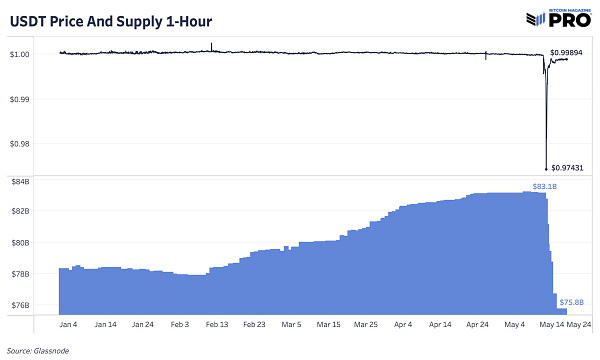BM Pro Daily - Stablecoin Market Overview
On May 13th, we covered the sudden decline in the price of USDT, which grabbed the attention of many in the industry, due to the sheer size of the stablecoin issued by Tether. In today’s issue, we will take a more in-depth look at the redemption mechanism of USDT, and cover why the concerns about the stablecoin and the apparent risks it presents to the bitcoin/cryptocurrency ecosystem.
Before digging in, it should be said that the advent of bitcoin on a long enough timeframe obfuscates the need for a “stablecoin,” which is really just a blockchain-based IOU held by a counterparty. A digital bearer asset that is completely stable on the protocol level and from an issuance and absolute supply perspective that can be held with no counterparty risk is the innovation. With that being said, the natural demand for dollars in the “crypto-economy” does make sense given the dollar’s incumbent status as the world reserve currency.


The supply of USDT stablecoin Tether has contracted by $7.3 billion from its all-time high reading, as redemptions flooded in as arbitrageurs and paranoid market participants alike rushed to convert USDT into banked USD.
In Tether’s latest breakdown of its reserves, USD cash made up around $4.2 billion of its assets, with the majority of the holdings ($34.5 billion worth) being made up of Treasury bills. $24.2 billion of its holdings was in commercial paper.
The unanswered question is whether the company's commercial paper holdings have been impaired at all given the recent macroeconomic disruptions around the world.
Given the decline in USDT supply, there is now the first month-over-month decline in aggregate USDT+USDC stablecoin supply in over two years.
With today’s release and focus on stablecoins, as well as the recent collapse of UST, an interesting window of opportunity for policymakers has emerged to provide guidance and clarity to stablecoin issuers, which would result in a rising demand for monetizing U.S. Treasury debt. After all, in the cryptocurrency ecosystem, USD stablecoins account for nearly 100% of stablecoin value. Given the dollar's role as the world reserve currency today, this makes intuitive sense.
The main takeaway from the rapid growth of stablecoins over the past two years is that despite the emergence of a digital monetary bearer asset with a fixed supply (bitcoin), there still is demand for a bearer instrument form of dollars, even if accompanied by trade-offs. All in all, a vibrant market for stablecoins ultimately will lead to smoother rails to bitcoin itself for those without access to the walled garden Western financial system, without offering the assurances of bitcoin’s monetary policy or decentralization.








